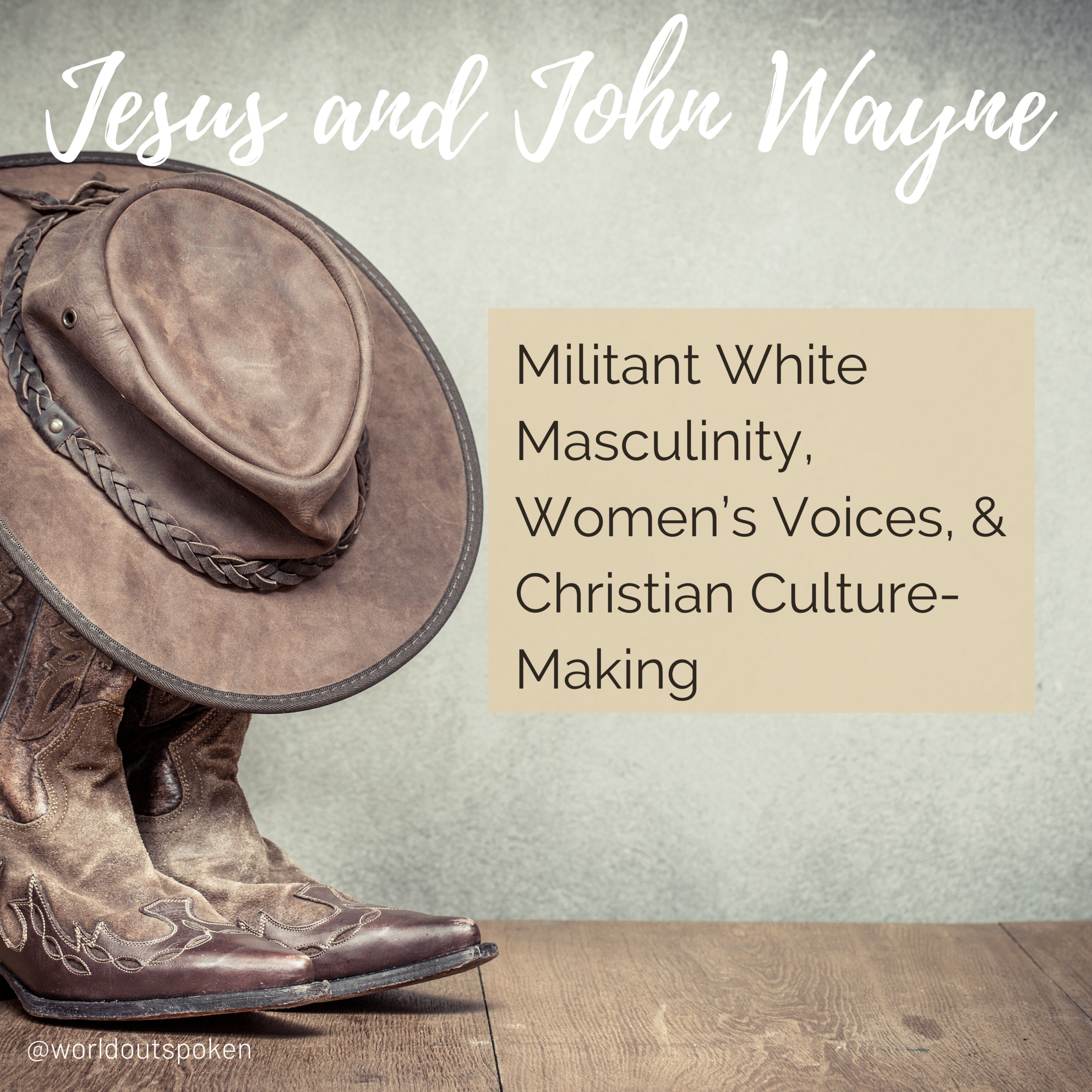White Masculinity and Theology
It was in graduate school that I first heard the phrase “contextual theologies.” I was intrigued since context - both cultural and historical - is crucial to understanding theology. While reading the assignment, I realized that contextual theologies are essentially theologies with an adjective placed in front: feminist theology, womanist theology, latinx theology, LGBTQ+ theology, liberation theology, black liberation theology, etc. You may notice (as I did) a couple of categories that are missing from these “adjectival” theologies: white theology and masculine theology. The reason is that these are assumed - the “mythical norm” of theologies, as it were.[1]
Since white, masculine voices have been privileged in the field of theology for centuries (or since voices were assumed to be white and male, regardless of the truth of that assumption), any attempt to equally privilege latinx, black, female, LGBTQ+, Asian, Indigenous, or any other perspective alongside those voices is often resisted. “Those'' voices, it is argued, are too influenced by their own subjective viewpoints and focus too much on one or two aspects of theology to be taken as seriously as the other (white and masculine) voices that have dominated for centuries. As if these white, masculine voices are not equally subjective and focused on particular issues.
What Kristin Kobes du Mez accomplished in Jesus and John Wayne is tracing a history of American white, masculine, evangelical theology and to identify the historical, cultural, and political forces that influenced, guided, and focused its theological emphases for decades. In the book, Kobes du Mez draws back the curtain on the assumption that American evangelicalism has developed its theological emphases and ecclesial ethics in some sort of vacuum outside of cultural influence - that it is not just as “adjectival” as any other sort of contextual theology. Kobes du Mez argues that the guiding force behind white evangelicalism for the last 50-some years has been a “militant white masculinity.”[2]
In a fascinating study that follows, Kobes du Mez traces the history of how “militant white masculinity” has always been the guiding force behind American evangelicalism and how it was shaped by and utilized symbols such as John Wayne, William Wallace, and other “rugged, masculine figures,” the Republican party, consumerism, and even the American military as an ideal force for good in the world.[3] Kobes Du Mez takes her readers on a dizzying journey through historical periods of evangelicalism that, despite its comprehensive nature, can only really scratch the surface of white evangelical subculture and all its manifestations. Beginning her history as far back as the 1890s, when the Victorian “model of manly restraint had begun to falter” and the new economy of the early twentieth century demanded a different type of “softer” work than toiling in fields or factories (and as women began to attend college with more regularity), Kobes du Mez records that a call for a new type of more aggressive masculinity emerged.[4]
Christianity as White, Militant, and Masculine
Kobes du Mez’s primary argument in Jesus and John Wayne is that this “militant white masculinity” has been the guiding force behind evangelicalism for decades. In so doing, she highlights more effectively than any theology textbook I’ve ever read just how contextual white masculine theology is. Perhaps one of the most devastating moments in her book is when she outlines how white evangelicalism was used to perpetrate segregation through church polity, Christian private education, and through both its constituents’ silence about and active railing against the Civil Rights movement. She does point out that “evangelicals’ response to civil rights varied, particularly in the early stages of the movement.”[5] Kobes du Mez uses Billy Graham as a prime example of one such evangelical leader who even personally removed ropes between white people and black people at his crusades and invited Martin Luther King, Jr. to pray at his 1957 New York City Crusade.[6] However, she also points out that he distanced himself from backing activists when they began to engage in civil disobedience, and that many white evangelicals responded similarly, finding it “hard to accept that the sin of racism ran deep through the nation’s history.”[7]
She argues that this lack of willingness among white evangelicals to continue standing by civil rights activists coupled with their silence about the demand for continued segregationist policies among their fellow white evangelicals had devastating effects. One of these was using private Christian schools to continue segregation and revealing that ultimately, white evangelicalism was more concerned with continuing its own political purposes than fighting for its black brothers and sisters. Kobes du Mez states, “Although blatant defenses of segregation and racial inequality would be rare, many southern evangelicals and fundamentalists who persisted in their unreconstructed views of race would find common cause with more ‘tolerant’ evangelicals on issues like social welfare policy and ‘law and order’ politics that would carry clear racial undertones.”[8]
Millennials from white evangelical spaces will recognize that similar patterns emerged in the genesis of the Black Lives Matter movement. Refusal to support that statement - “Black Lives Matter” - was defended by many white evangelicals because they claimed that the movement had ties to a more liberal political agenda and that the civil rights activists within the movement were anti-police. This movement drew fault lines across white evangelicalism that, for some, resulted in splitting away from the evangelical church due to its refusal to support what they viewed as a basic civil rights issue. These divisions only became more pronounced when Donald Trump was elected as the Republican party’s candidate for the 2016 election. What was not widely recognized, however, was that these patterns had been present in white evangelicalism from its very start. The widespread reception of Jesus and John Wayne by those of us who grew up (or are still part of) white evangelicalism has been a resounding agreement that the book puts its finger on exactly what felt off as we grew up, particularly surrounding issues of race, “family values” voting, and the strong connection to the U.S. military (which is brilliantly outlined in Chapter 12, entitled, “Pilgrim’s Progress in Camo”).[9]
Where are the Women?
For me, one of the most eye-opening chapters of Kobes du Mez’s book was Chapter 11, provocatively entitled, “Holy Balls.” While some readers may be drawn to other chapters, this chapter described the period of my life when my faith was becoming my own. I found my heart feeling twisted as I realized how whole-heartedly I had swallowed certain parts of toxic masculinity because I truly believed Scripture demanded that I did, and because much of the Christian culture around me absolutely encouraged me to do so. Kobes du Mez begins the chapter with some less common examples of militant masculinity, such as churches hosting MMA viewing parties and Christian mixed-martial arts groups, but speaks to the heart of what was happening at the time by saying, “As militant masculinity took hold across evangelicalism, it helped bind together those on the fringes of the movement with those closer to the center, making it increasingly difficult to distinguish the margins from the mainstream.”[10]
A poignant example of this collapsing of the margins into the mainstream is the support New Calvinism gave to two “fringe” voices in the early 2000’s: Mark Driscoll and Doug Wilson. Kobes du Mez writes more in-depth about these two men and the way that they were given platforms and endorsements by the leaders of New Calvinism despite many of them expressing discomfort with their crass talk, sometimes violent focus, and even, in one case, denial that American slaves had been treated with brutality.[11] This, to me, was the gut-punch of the chapter. These two men were endorsed by other men who were at the heart of founding various church-planting networks and conferences that were wildly popular among me and my peers during college specifically, and their endorsements meant a great deal. While these organizations and coalitions claimed to hold the gospel message as the most important thing, Kobes du Mez points out that the unifying factor among many of these very doctrine-conscious men was not solely the simple gospel message, but “gender and authority.”[12]
“It was both disheartening and a reminder to me of where my place was at all times - out of the pulpit and out of any leadership that was not solely over women or children. Knowing that I wasn’t going to seek pastoral leadership was far more important to these men than my love for Christ, desire to serve the Church, and my passion for theology, and that oft-repeated question made it painfully clear.””
These two examples most brutally highlight her point about gender and authority trumping simple gospel messaging within white evangelical alliances, but so does the lack of female leadership in many churches that ascribe to this New Calvinism. Sure, there are shining exceptions, but the question I was most often asked when I stepped into a new church in the early aughts is most illustrative - “Why do you want to study theology?” which was code for “Do you want to be a pastor?” It was both disheartening and a reminder to me of where my place was at all times - out of the pulpit and out of any leadership that was not solely over women or children. Knowing that I wasn’t going to seek pastoral leadership was far more important to these men than my love for Christ, desire to serve the Church, and my passion for theology, and that oft-repeated question made it painfully clear.
One area of critique that I have for Jesus and John Wayne is the book’s claim to analyze how white evangelicals got to where they are today, while women are conspicuously absent from many of the chapters as perpetrators of this “militant white masculinity” that Kobes Du Mez describes. It was not simply men advocating for patriarchal norms in churches, nor was it only men leading the “family values” Christian Right, but women were crucial in the formation of and enforcement of this “militant white masculinity,” and one place the book falls short is in fully demonstrating that. A notable exception is Chapter Two (entitled “God’s Gift to Man”), in which Kobes Du Mez highlights women such as Marabel Morgan and her The Total Woman course, Anita Bryant, Elisabeth Elliot, and Phyllis Schlafly. Kobes du Mez continually documents Schlafly’s influence among white evangelicals (particularly politically) throughout the book, which is utterly engrossing for anyone (like me) who had not known much about this woman before. However, Schlafly appears to be the sole woman whose contribution to “militant white masculinity” is traced throughout the entire book. While I think it is important to include white women’s culpability in the propagation of “militant white masculinity,” Kobes du Mez has recently announced that she will be publishing a new book about evangelical women called Live, Laugh, Love, and I believe she intends to address much of what she left out in Jesus and John Wayne within that book. I, for one, look forward to reading it.
Christianity, Consumerism, and a Dangerous “Culture-Making”
One poignant observation Kobes du Mez makes in Jesus and John Wayne is the way that white evangelicals harnessed consumerism to propagate their cultural message.[13] By doing so, they created their own culture and provided a weapons store for the culture war that consumed much of their recent history. This culture was created through celebrity culture (particularly as pertained to pastors, radio stars, and motivational speakers), radio ministry, Christian television shows, the Christian music industry, Christian films, the Christian book publishing business, and Christian bookstores.
Andy Crouch has written much about culture and culture making. In For the Beauty of the Church: Casting a Vision for the Arts, he describes how Genesis informs our understanding of culture making by demonstrating how God was the first culture maker and cultivator - planting a garden, which Crouch calls “nature plus culture.”[14] He describes the call of those in the Church to create good and beautiful art and other such cultural contributions. Crouch speaks of culture making as a creative, positive endeavor that the Church ought to participate in joyfully, creating art in and for the Church as well as for the world. Through the creation story, he highlights that the problem with culture making occurs when Adam and Eve no longer wait on and partner with God, but “...take and eat, and set in motion the process by which everything that God had originally given as a gift, a sign of relationship and dependence, will be twisted into a right, something grasped from a world presumed to be threatened and threatening, something that insulates us from needing relationship or dependence.”[15]
“Culture making, in the form that Kobes Du Mez documents, is dangerous, homogenizing, and used as a battering ram against anyone who stands in its way or disagrees with its narrative. It also robs white evangelicals of the incredible gift of listening to the voices of their many siblings in Christ who could expand, correct, lead, and joyfully participate in culture making alongside them had the culture wars they participated in not eradicated that focus on relationship and dependence.”
In this description of the Fall, Crouch illustrates precisely what Kobes du Mez identifies as problematic with white evangelicalism’s attempt at culture making. White evangelicals took the gift of cultural creation given by God and twisted it into a utilitarian tool used to fight a culture war - usually shouting about rights rather than gifts (whether second amendment rights, rights to gather around a flagpole at a school and pray, rights to not have to pay taxes to support people “on welfare,”, rights to defend “traditional family and cultural values,” etc.). By taking that gift of cultural creation and fashioning it into a weapon, white evangelicalism lost sight of the gift of relationship and dependence on other Christians. The reverberations of their culture war drowned out the voices of brothers and sisters who had something to contribute to the conversation about culture, and their warring cost them the opportunity to participate in culture-making alongside them.
This was not the only negative effect; when white evangelicals invited siblings of color into their spaces, they acted as gatekeepers to the culture making of that space. While siblings of color were invited to contribute to the worship teams, lead the youth groups, and act as outreach coordinators, rarely were they given roles of actual leadership to set the priorities of churches and organizations. If they stepped outside of white evangelicalism’s priorities for culture making, they were instructed to “get in line” or get out. Many chose the latter after years of being silenced and abandoned by those in leadership. Culture making, in the form that Kobes Du Mez documents, is dangerous, homogenizing, and used as a battering ram against anyone who stands in its way or disagrees with its narrative. It also robs white evangelicals of the incredible gift of listening to the voices of their many siblings in Christ who could expand, correct, lead, and joyfully participate in culture making alongside them had the culture wars they participated in not eradicated that focus on relationship and dependence.
So, What Now?
Jesus and John Wayne provided for me the context of what was happening backstage during my childhood, adolescence, and young adulthood. The reason the book resonates so strongly with so many (particularly white) evangelicals is that it gives answers to questions we never knew how to ask. It also articulates what our young minds may not have yet had the maturity to say about the culture wars we lived through, and in many cases, were even used as agents in.
Kobes du Mez successfully articulated a succinct, utterly readable account of the last 50-some years of white American evangelicalism, and whether you agree with her thesis or not, the book’s already astounding cultural impact will force you to grapple with it in your churches, schools, and institutions. And this is a very good thing, because so many of the historical and recent events that she brings to light have needed to be wrestled with for a very long time in a way that accounts for the historical context surrounding them and without making apologies for being bold enough to articulate what was wrong about those events.
Kobes du Mez’s historical account of white evangelicalism and how we got to where we are succeeds in highlighting a theological point: all theologies are contextual theologies. Even (and especially) white masculine evangelical theology, though the way it is often taught in many university, seminary, and Sunday school classrooms over the years may argue otherwise. Just as feminist, black liberation, womanist, latinx, or any other “contextual” theology has a cultural and historical context, so does white theology and masculine theology. More than any theology textbook I’ve read, Kobes du Mez demonstrates the danger of prioritizing one viewpoint as normative, simply by laying out the history.
So, is there hope for white evangelicalism? Kobes du Mez seems to think so, ending her book by saying, “What was once done might be undone.”[16] It all depends on us. If we as white evangelicals and former white evangelicals react to her description and critique of how we got here with defensiveness and a plugging of our ears, we are only doing more of the same. However, if we begin to consider Crouch’s culture making and what Makoto Fujimara has called culture care, perhaps we can find a way forward. Any way forward must involve focusing on relationship and dependence once more - not just including diverse voices at our tables in minor roles, but in submitting to those voices humbly (even if they no longer trust our tables and have built their own). It must also involve putting in the long hard work to earn back trust, and eventually, culture-making together again, joyfully participating in creation with one another and with the God we serve together.
About Luci Frerichs Parrish
Luci Frerichs Parrish is a Midwestern native living in the South. She lived on the South Side of Chicago for seven years, working in various non-profit and church ministries. She has an M.A. in Theology from Wheaton College Graduate School with an emphasis in Systematic Theology. Her current areas of study include systematic theology, theological aesthetics, and ecclesiology. She is a coffee enthusiast, independent bookstore fanatic, and Pittsburgh Penguins fan. She is passionate about doing theology to serve the local and global church.
Footnotes
[1] Audre Lorde defines the “mythical norm” as “white, thin, male, young, heterosexual, Christian, and financially secure.” Audre Lorde, “Age, Race, Class, and Sex: Women Redefining Difference,” in Sister Outsider: Essays and Speeches (Trumansburg, NY: Crossing Press, 1984), 116.
[2] Kristin Kobes du Mez, Jesus and John Wayne: How White Evangelicals Corrupted a Faith and Fractured a Nation (New York, NY: Liveright Publishing, 2020), 4.
[3] See Ted Cruz’s now-infamous quotation of William Wallace at CPAC 2021 for a relevant current example of this exact point. See also Kobes du Mez, Jesus and John Wayne: How White Evangelicals Corrupted a Faith and Fractured a Nation (New York, NY: Liveright Publishing, 2020), 4.
[4] Ibid.
[5] Ibid, 37.
[6] Ibid., 37-38.
[7] Ibid.
[8] Ibid, 39.
[9] Ibid, 205.
[10] Ibid, 187-188.
[11] Ibid, 202.
[12] Ibid, 204.
[13] Though white evangelicals are certainly not the only American Protestants to do so!
[14] Andy Crouch, “The Gospel: How Is Art a Gift, a Calling, and an Obedience?” in For the Beauty of the Church: Casting a Vision for the Arts, ed. W. David Taylor (Grand Rapids, MI: Baker Books, 2010), 32.
[15] Ibid, 34.
[16] Kobes du Mez, 304.
































